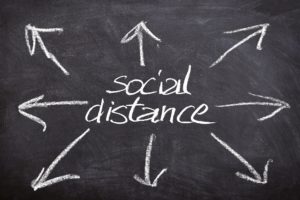COVID-19 UPDATE: PLEASE DON’T TOUCH!

PLEASE DON’T TOUCH!
SOCIAL DISTANCING IS OUR SAFEST BET

Following the President’s directive of 15th March, 2020 requesting companies to consider a work from home policy, a majority of entities were caught flat-footed with many admittedly not having contingency plans in place in the wake of the COVID-19 pandemic.
This was part of what has now become the most talked about phrase in recent history being, “social distancing”.
What is social distancing?
It is the un-pharmaceutical way of preventing spread of contagious diseases.
In simple terms, it is putting space between yourself and the next person. This means not coming into contact with other people unless you need to.
How do you implement social distancing?
This means not going to visit people’s houses, no parties, clubs, bars, sporting events, restaurants, inter alia and where applicable, working from home. In instances where one is unable to work from home and must commute to the office, there is need to re-schedule travel times to avoid rush hour/ busy times to reduce risk of infection.
While at work, employers will need to re-organize sitting arrangements to ensure that employees keep a distance of at least 1.5 meters from each other.
Whereas everyone is at risk of infection, special precaution is needed for persons especially at risk (including pregnant women, persons over the age of 70 and those with compromised immune systems). Such persons should consider making additional adjustments to their day-to-day chores such as going grocery shopping at less busy times or less crowded stores.
How practical is it?
There are some who have contended that social distancing may not work in our current set-up touting the excuse that it is “un-African” not to greet each other by hand; or visit one another. African or not, it does not matter! Fact remains that human contact is the quickest and surest way to pass on the infection.
However, implementation of social distancing may prove to be a challenge owing to the economic incapability of many. In Kenya more than half of the work force is made up of the informal sector with many reportedly in “daily wage” work such as construction, service industry such as cleaning, security, hotelier etc. and thus may not be able to afford the “luxury” of taking time off.
There is also the question of how exactly does it work in a household with many people in confined spaces. The issue of adequate affordable housing is something that the Government has grappled with for a long time. Per a report by SID Kenya published in October, 2019 approximately 70% of Nairobi residents live in single-room units in informal settlements and tenements. Additionally, with the call for Kenyans to exercise proper hygiene to manage the spread of the virus, 41% of Kenyans still rely on unimproved water sources such as ponds, while 59% use unimproved sanitation solutions.
WORKING FROM HOME– it is NOT parte after parte time!

Practical ways to work from home EFFECTIVELY:
- Maintain a similar schedule by waking up the same time, getting dressed and ready for work as you would any other day of the week
- Take walking meetings when you can. If you have a phone call that you don’t need to be in front of a computer to take, pick up the phone or your Bluetooth headphones and walk around the house or if possible get outside. This will help reduce monotony.
- Meal and snack prep and maintain the same eating habits.
- Transfer your commute time to intentional rest time. This is time for us to detach from our work. Instead of starting our day off by stressing out about getting somewhere on time, invest that time into either a relaxing ritual that gets you to a calm and clear state of mind or invest it into winding down your day so that you don’t form a habit of working into the night.
- Remove distractions from your work space.
- For those with children at home, consider asking a neighbor to allow you to work from their home. However, in doing so, you must take all the necessary precaution not to expose yourself or your neighbor to any risks of infection. This includes sanitizing and washing your hands regularly.

